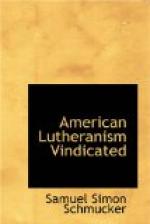Thirdly, they forget that Luther himself never saw, much less approved, the most objectionable and stringent of these books, the Form of Concord, the profession of which they would make essential to Lutheranism.
Fourthly, they overlook the fact that entire Lutheran kingdoms, such as Denmark and Sweden, from the beginning rejected some of these books, and yet are everywhere acknowledged as Lutherans.
Fifthy, [sic] they forget that the Form of Concord itself professes to regard Confessions of faith only an exhibitions of the manner in which Christians of a particular age understand the Scriptures; implying that they were not supposed even by the authors of the symbolic system themselves to be unchangeable, although their incorporation with the civil law of the land, closed the door against all subsequent improvement.
A revision of our symbolic standpoint, is therefore perfectly consistent with primitive Lutheranism; and according to the Congregational or Independent principles of Lutheran church government, advocated by Luther, and hitherto practiced on by our American church, as well as avowed by the Constitution of the General Synod, each District Synod is competent to do this work for herself as long as she retains “the fundamental doctrines of the Bible as taught by our church.”
How then can this important work be best accomplished, of releasing ourselves on the one hand from the profession of the errors contained in the Confession, and on the other of avowing the unadulterated truths of God’s word?




